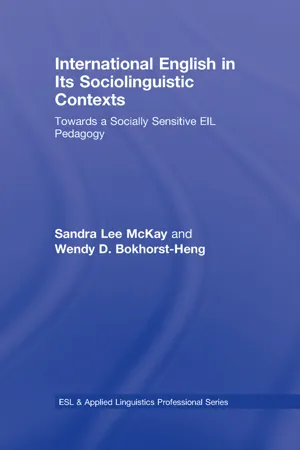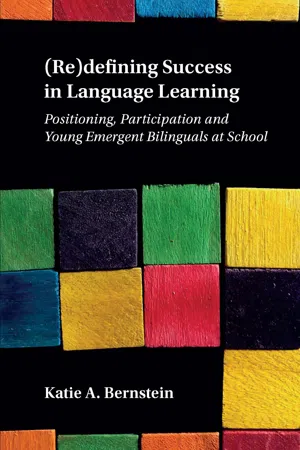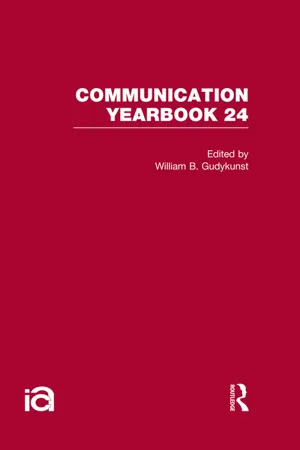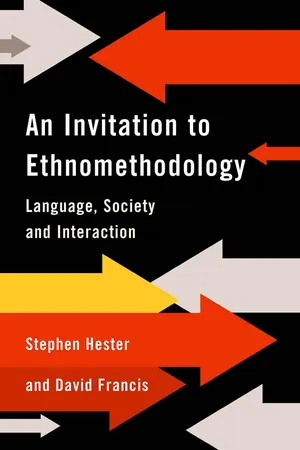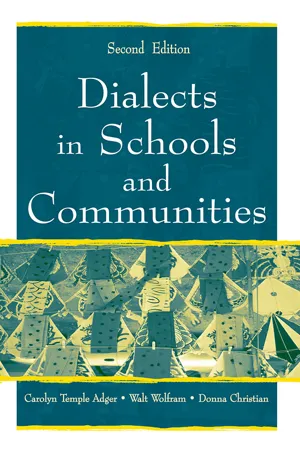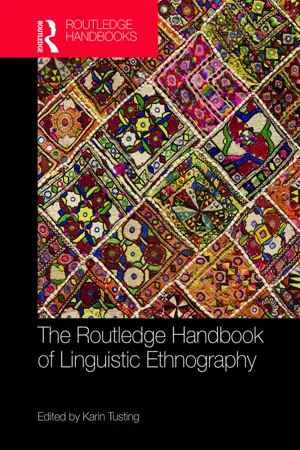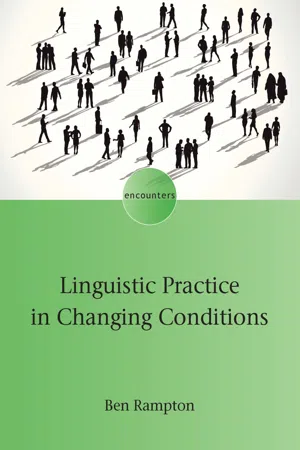Languages & Linguistics
Social Interaction
Social interaction refers to the ways in which individuals engage with one another in a social setting. It encompasses verbal and non-verbal communication, as well as the exchange of information, emotions, and behaviors. In the context of languages and linguistics, social interaction plays a crucial role in shaping language use, acquisition, and development.
Written by Perlego with AI-assistance
Related key terms
12 Key excerpts on "Social Interaction"
- eBook - ePub
International English in Its Sociolinguistic Contexts
Towards a Socially Sensitive EIL Pedagogy
- Sandra Lee McKay, Wendy D. Bokhorst-Heng(Authors)
- 2017(Publication Date)
- Routledge(Publisher)
Chapter 6 Interactional sociolinguisticsIn this chapter we examine how interactional sociolinguistics can provide insight into the use of English in an era of globalization. The chapter begins with an overview of the central figures and tenets of interactional sociolinguistics. Using this background, we examine existing research regarding EIL interactions. Specifically, we explore the ways in which interactional sociolinguistics has been beneficial in providing insight on:f• English as a lingua franca (ELF) interactions;• the code-switching behavior of bilingual users of English; and• bilingual users’ attitudes toward code-switching.In each section we will consider the manner in which the topic has relevancy for EIL pedagogy.Defining interactional sociolinguistics
Historical development
Interactional sociolinguistics developed out of linguistics, sociology, and anthropology. Current interest in interactional sociolinguistics began largely as a reaction to Chomsky’s (1957) view of language as a fixed universal property of the human mind that exists devoid of context. A major challenge to Chomsky’s view of language was the work of Hymes (l974), a linguistic anthropologist, who argued that a description of language must take into account the social knowledge that individuals bring to linguistic interactions. Hymes argued that researchers interested in describing how language is used need to consider the context in which particular interactions take place and how this context affects the inter-action. Specifically, Hymes (1972) maintained that the following four questions must be raised in analyzing language use. - eBook - ePub
The Exercise of Power in Communication
Devices, Reception and Reaction
- R. Schulze, H. Pishwa, R. Schulze, H. Pishwa, R. Schulze, H. Pishwa(Authors)
- 2015(Publication Date)
- Palgrave Macmillan(Publisher)
During recent decades, linguists have put the traditional concepts of the lexicon and the grammar onto a new footing, as, for example, witnessed by Römer and Schulze (2009, 2010) and the contributions therein. A major reason for this revision are new insights and discoveries in the cognitive sciences and related disciplines that are principally concerned with knowledge representation and the requisite processes for its management (as, for example, illustrated in Pishwa (2009) and the contributions therein). There is a consensus among these linguists that the primary function of language is communication, and human beings, who are fundamentally social in character, use language as a tool to interact with others. One key aspect of Social Interaction involves the ‘publicizing’ of knowledge, i.e. ideas about entities and events that are not immediately present, in order to make them accessible to those who lack these particular ideas about entities and events. Other key aspects of Social Interaction involve, on the one hand, the strengthening of social relationships that are vital for the reinforcement of bonds between individuals, and on the other hand the highlighting of social distinctions. The latter aspect includes, among others, different ways of talking to friends, of talking to those younger or older or of talking to employees or superiors. Although there is no overall agreement as to how language-in-use is linked to cognition in general, Chilton (2009: 455) treads unknown territory in arguing in the context of Cognitive Linguistics ‘[…] that social meanings exist in people’s minds, that is, in their brains’.The careful scrutiny of different ways of talking to one another, i.e. ‘doing interaction’, reveals two descriptive and analytical dimensions of social relation or interpersonality: the vertical dimension of power and the horizontal dimension of solidarity (Goatly 2012: 122). The asymmetrical type manifests itself through control, dominance, expertise, force, institutional authority, or status; the symmetrical type is built on affection, closeness, friendliness, love, solidarity or warmth. - eBook - ePub
(Re)defining Success in Language Learning
Positioning, Participation and Young Emergent Bilinguals at School
- Katie A. Bernstein(Author)
- 2020(Publication Date)
- Multilingual Matters(Publisher)
While interaction plays a role in nearly all theories of second language acquisition, the view that interaction is both a place for language learning as well as for the construction of social relationships and structures is a broadly sociocultural one. Vygotskian sociocultural theory, which was brought to the field of Second Language Acquisition through the work of Rick Donato, Jim Lantolf, Merrill Swain and Steve Thorne, among others, theorizes that learning is a process of internalization and appropriation. Any new skill appears first on the social plane, through participation in interaction with others, and then, later, on the individual plane (Vygotsky, 1978). Through interaction, children learn to use artifacts, or cultural tools – more concrete ones, like spoons or markers, to more abstract ones, such as language and gesture – to mediate their goal-driven activity. For second language researchers who draw on Vygotskian sociocultural theory, interaction is at the core of language learning, which takes place through participation in ‘cultural, linguistic, and historically formed settings such as family life and peer group interaction’ (Lantolf & Thorne, 2007: 197). Far from simply providing input, interaction is the location of learning itself.Specifically, Lantolf (2000, 2013; Lantolf & Thorne, 2006, 2007) described interaction as mediating L2 learning in two important ways. First, it provides opportunities to understand and appropriate others’ intentional ways of using language to participate in activity. Second, it enables learners to use language in ways that are just beyond their individual capabilities, in their zones of proximal development, or the range of activities that a person cannot yet complete independently, but can in cooperation with another person. Donato (1994, 2000) and Swain (1997; Swain et al., 2002) described similar learning processes, which they called ‘collective scaffolding’ and ‘collaborative dialogue,’ respectively. Through these interactions with others, learners appropriate language that they can then rehearse in private speech or use productively in other interactions. Importantly, from a sociocultural perspective, development and learning are not individual processes. Instead, they involve appropriation and internalization of intro-individual social activity. Sociocultural theory thus dispenses with the dichotomy between the individual and the social, as well as between the cognitive and the cultural. All development, and the learning that precedes it, is both social and cultural. There is no ‘that which surrounds.’ This is also true in the second theoretical perspective Cole mentioned: practice theory.Language – and Human Activity – as Social PracticePractice theory was developed by sociologist Pierre Bourdieu (1977, 1990), as a way to overcome what he saw as three related and false dichotomies in sociological and anthropological research: objectivity and subjectivity, positivism and phenomenology, and structure and agency. The first in each set come together in the researcher striving to view human activity as an outsider, looking down from above in order to create a stable account of patterns and routines, by, for example, mapping the daily schedule in a prekindergarten classroom. The latter in each pair convene in attempts to understand the ‘native perspective,’ or personal experience of, say, being the new kid in school or the parent of a child with a disability. For Bourdieu, the former approach reduces human activity to acting out predetermined roles on stage or to executing prewritten plans, while the latter ignores everything outside individual experience, including the conditions, such as relations of power, that made that experience possible. With practice theory, Bourdieu sought to bridge the two and to understand how structure sets the conditions for human activity without determining it and how activity (re)produces those structures. He accomplished this through the notions of habitus and field. - eBook - ePub
- William Gudykunst(Author)
- 2012(Publication Date)
- Routledge(Publisher)
16 Language and Social Interaction: Taking Stock and Looking Forward Ann Weatherall Victoria University of Wellington Cynthia Gallois Jeffery Pittam University of QueenslandThe Language and Social Interaction Division of the International Communication Association attracts a membership from a wide range of disciplines. The unifying concern of language and Social Interaction (LSI) researchers is to understand how communication works through the empirical study of everyday language use and talk in Social Interaction. This essay, along with Sanders, Fitch, and Pomerantz’s contribution to this volume in Chapter 17 , describes the distinctive features of LSI research. This chapter sketches four major approaches to the field: conversation analysis, ethnography of communication, discourse analysis, and language and social psychology. The present state of theory and research is considered under the broad headings of power and identity, central concerns of LSI researchers. The tensions that emerge as a result of the different perspectives and commitments of LSI scholars are considered, and a research agenda aimed at resolving these tensions is outlined.A S a field, language and Social Interaction (LSI) research is concerned with exploring the details of human discourse and interaction. The primary focus of the Language and Social Interaction Division of the International Communication Association, as outlined in the divisional statement, is on interpersonal and group settings, either face-to-face or mediated (e.g., by telephone or computer). The simplicity of this statement belies the sophisticated theoretical and methodological approaches that characterize the research of the division’s mem- bership. LSI research is a multidisciplinary endeavor, as the special end-of-millennium issue of the journal Research on Language and Social Interaction - Jim King, Jim King(Authors)
- 2016(Publication Date)
- Palgrave Macmillan(Publisher)
9 The Dynamic Interplay between Language and Social Context in the Language Classroom: Interpersonal Turn Taking for ELF Learners Michael Handford Language socialisation and language learningHow important is social context when considering language learning? When comparing cognitive and sociocultural approaches, the former still form the considerable bulk of research into SLA (Zuengler & Miller, 2006; Dörnyei, 2009). Nevertheless, several approaches that attempt to account for second language learning from a social perspective have more recently been developed, including those working with Vygotskian sociocultural theory (Lantolf, 2000) and language socialisation (Ochs, 1996). The present study draws on work in language socialisation, specifically that of Ochs (1988, 1996), and also functionally/socially oriented discourse analysis (e.g., Halliday, 1989; Gee, 2011, 2012) to enable learners to achieve their communicative goals through effective manipulation of the social context through discursive choices. It approaches language acquisition in terms of ‘the systematic relationship between the social environment on the one hand, and the functional organisation of language on the other’ (Halliday, 1989, p. 11) and prioritises a sociocultural perspective in the language classroom. As such, while this study contrasts with others explored in the present volume in that it does not draw directly on dynamic systems theory, it shares with DST an interest with change over time (see Dörnyei, 2009, p. 111), an acknowledgement of the importance of social and environmental factors, and views language ‘not as a collection of rules and target forms to be acquired, but rather a by-product of communicative processes’ (Ellis cited in Dörnyei, 2009, p. 104).- eBook - ePub
An Invitation to Ethnomethodology
Language, Society and Interaction
- David Francis, Stephen Hester(Authors)
- 2004(Publication Date)
- SAGE Publications Ltd(Publisher)
1Social Interaction, Language and Society
This book is about how society is accomplished in and through Social Interaction, how language is central to this accomplishment and how the interactional nature of social life may be investigated. We invite the reader to share in not only a particular vision of social life, as constituted in and through language and Social Interaction, but also a form of sociological inquiry that is consistent with and follows from this vision. This form of inquiry is known as ethnomethodology. In this chapter we outline the nature of our conception of social life by considering in turn its three key ideas or components: Social Interaction, language and society. In the next chapter we explain what we mean by ethnomethodology. In the chapters to follow, various aspects of social life are considered from the point of view we propose. We present analysis and discuss studies consistent with this approach and explain how they implement the form of sociological inquiry that we are recommending. Our overall aim is not just to show what is involved in doing ethnomethodology, but also to invite the reader to try for him- or herself this way of doing sociology.Social Interaction
What we refer to as ‘society’ is made up of social activities of many different kinds. What makes these activities ‘social’ is that they are done with or in relation to others. Some activities are collective activities – these are done by several or many persons acting together. Examples of such collective activities are a family meal, a business meeting, a football match or a political election. Other activities may be done by a single individual but with reference to others, or in a context that involves and is made possible by other people. Examples of this are getting dressed in the morning, walking along the street, reading a book or writing a letter. Such activities can be referred to as ‘individual’ activities so long as it is remembered that, like collective activities, what is done and how - eBook - ePub
- Ilona Roth, Ilona Roth(Authors)
- 2020(Publication Date)
- Psychology Press(Publisher)
For communication to be successful it is essential to take into account the listener’s prior knowledge (given-new contract) and to tailor language for a particular audience (audience design). This is essential for the listener to make the appropriate bridging inferences.- According to speech act theory, the intentions of utterances are more important than their literal meaning. Context is necessary for identifying indirect speech acts.
- Conversations can be considered as communication episodes which are embedded in social encounters.
- Language styles vary in accordance with the social status of participants and the requirements of the social setting.
5 The social dimension: an overview
As this chapter has progressed, the aim has been to emphasize the role of language in social communication. The social dimension is so dominant that it is impossible to think of language existing without speakers. It is equally impossible to visualize a human society without the ability to communicate with others. However, running through this chapter has been a tension between the internal aspects of language and its social functions. This was first raised in Section 2 in connection with the question as to whether the way people think is determined by the language used by their community. The question at issue is the relationship between private thoughts and the role of language in maintaining a particular society’s conventions and norms. As Vygotsky (1962) pointed out, it is extremely important that people use the same language for private thinking and for public social communication. Only by doing so will they be able to pass on the fruits of their thinking to other people, and to internalize and reflect on communications from other people.The reason why language is so crucial in mediating the way people view the world is that language has a peculiar advantage compared with other types of experience. Linguistic symbols are at one remove - eBook - ePub
- Carolyn Temple Adger, Walt Wolfram, Donna Christian(Authors)
- 2014(Publication Date)
- Routledge(Publisher)
culture—applies more broadly: It usually refers to a group that shares values, behavioral norms—including norms for interaction—and beliefs about the nature of the world. There is a significant overlap between dialect groups and cultural groups, especially when social dialects are considered. Members of cultural groups may use a dialect to highlight solidarity and resist assimilation. In fact, anthropologist Fordham (1998) found that in the high school where she did field work, African American students used African American English as one way of refusing to comply with culturally alien aspects of schooling. A similar phenomenon was found among middle-age native islander men on Martha’s Vineyard off the coast of Massachusetts and on the Outer Banks island of Ocracoke off the coast of North Carolina. Feeling challenged by tourists from outside the island, these men highlighted and heightened dialect features as a kind of resistance to outside social forces (Labov, 1963; Wolfram & Schilling-Estes, 1995).Language as a form of cultural behavior and an identifying feature of cultural groups involves more than the basic features of dialect. It involves Social Interaction. Interaction and dialect are inevitably intertwined in language behavior differences between groups and in contributing to the social attitudes toward those differences.This chapter outlines some important dimensions of language use in Social Interaction, emphasizing that cultural groups and speech communities may display unique patterns. Such contrasts between groups can be perplexing to students and teachers alike. As with dialect differences, teachers may find that investigating interaction in their classrooms will help them and their students see some regular patterns associated with cultural groups and understand their meaning.Conversational PolitenessSocial Interaction is similar to driving in traffic: There are some basic, underlying rules that individuals must follow if the enterprise is going to work. The important consideration is not which side of the road to drive on, but the fact that everyone agrees about it. Although drivers are individually more or less considerate of each other, what people do behind the wheel must be generally responsive to what others are doing, as well as to such basic conventions as driving on the right or left side of the road. Some driving patterns are culturally influenced, and some are fairly universal. Many rules of the road are taught, but others are tacit, and drivers may not realize the extent to which their driving patterns respond to others’. - eBook - ePub
- Karin Tusting, Karin Tusting, Karin Tusting(Authors)
- 2019(Publication Date)
- Routledge(Publisher)
This theorisation has major implications for our understanding of ‘context’. As noted above, word denotation, the formal structures of grammar and the propositional meaning of sentences still count, but they lose their traditional supremacy in linguistic study, and instead become just one among a large array of semiotic resources available for the local production and interpretation of meaning. Language is regarded as pervasively indexical, continuously pointing to persons, practices, settings, objects and ideas that never get explicitly expressed, and in what Erickson calls a “Copernican shift in perspective within sociolinguistics” (2011, p. 399), context stops being the relatively static, external and determining reference point traditionally added to language analysis as something of an afterthought – what Drew and Heritage call the ‘bucket’ theory of context (1992, p. 19) – and is instead seen as dynamic, interactively accomplished and intrinsic to communication.So context is an understanding of the social world activated in the midst of things, an understanding of the social world that is interactionally ratified or undermined from one moment to the next as the participants in an encounter respond to one another. At the same time, however, when people engage with one another, there is considerable scope for social difference in the norms and expectations that individuals orient to, as well as in the kinds of thing they notice as discrepant, and there can also be a great range in the inferences that they bring to bear (‘good’ or ‘bad’, ‘right’ or ‘wrong’, ‘art’ or ‘error’, ‘call it out’ or ‘let it pass’, ‘typical of this or that’). The normative expectations and explanatory accounts activated like this in the interactional present seldom come from nowhere. Instead, they instantiate discourses that the participants have picked up through prior involvement in socio-communicative networks that can range in scale from intimate relationships and friendship groups to national education systems and global media – “what we perceive and retain in our mind is a function of our culturally determined predisposition to perceive and assimilate” (Gumperz, 1982, p. 12). In this way, the notions of inferencing and contextualisation offer us a way of seeing how long-term experience and more widely circulating ideologies infuse the quick of activity in the here-and-now, introducing the force of social expectation/‘structure’ without overlooking the participants’ skilled agency (cf. Blommaert & Rampton, 2011, p. 11). - eBook - ePub
- Ben Rampton(Author)
- 2021(Publication Date)
- Multilingual Matters(Publisher)
This theorisation has major implications for our understanding of ‘context’. As noted above, word denotation, the formal structures of grammar and the propositional meaning of sentences still count, but they lose their traditional supremacy in linguistic study, and instead become just one among a large array of semiotic resources available for the local production and interpretation of meaning (cf. Hanks, 1996; Verschueren, 1999). Language is regarded as pervasively indexical, continuously pointing to persons, practices, settings, objects and ideas that never get explicitly expressed and, in what Erickson (2011: 399) calls a ‘Copernican shift in perspective within sociolinguistics’, context stops being the relatively static, external and determining reference point traditionally added to language analysis as something of an afterthought – what Drew and Heritage (1992: 19) call the ‘bucket’ theory of context. Instead, it is seen as dynamic, interactively accomplished and intrinsic to communication.So context is an understanding of the social world activated in the midst of things, an understanding of the social world that is interactionally ratified or undermined from one moment to the next as the participants in an encounter respond to one another. At the same time, however, when people engage with one another, there is considerable scope for social difference in the norms and expectations that individuals orient to, as well as in the kinds of thing they notice as discrepant, and there can also be a great range in the inferences that they bring to bear (‘good’ or ‘bad’, ‘right’ or ‘wrong’, ‘art’ or ‘error’, ‘call it out’ or ‘let it pass’, ‘typical of this or that’). The normative expectations and explanatory accounts activated like this in the interactional present seldom come from nowhere. Instead, they instantiate discourses that the participants have picked up through prior involvement in sociocommunicative networks that can range in scale from intimate relationships and friendship groups to national education systems and global media – ‘what we perceive and retain in our mind is a function of our culturally determined predisposition to perceive and assimilate’ (Gumperz, 1982: 12). In this way, the notions of inferencing and contextualisation offer us a way of seeing how long-term experience and more widely circulating ideologies infuse the quick of activity in the here-and-now, introducing the force of social expectation (aka ‘structure’) without overlooking the participants’ skilled agency (cf. Blommaert & Rampton, 2011a: 11). - eBook - ePub
Foundations in Sociolinguistics
An ethnographic approach
- Dell Hymes(Author)
- 2013(Publication Date)
- Routledge(Publisher)
Such a goal is of concern to practical work as well as to scientific theory. In a study of bilingual education, for example, certain components of speaking will be taken into account, and the choice will presuppose a model, implicit if not explicit, of the interaction of language with social life. The significance attached to what is found will depend on understanding what is possible, what universal, what rare, what linked, in comparative perspective. What survey researchers need to know linguistically about a community, in selecting a language variety, and in conducting interviews, is in effect an application of the community’s sociolinguistic description (see Hymes 1970a). In turn, practical work, if undertaken with its relevance to theory in mind, can make a contribution, for it must deal directly with the interaction of language and social life, and so provides a testing ground and source of new insight.Sociolinguistic systems may be treated at the level of national states, and indeed, of an emerging world society. My concern here is with the level of individual communities and groups. The interaction of language with social life is viewed as first of all a matter of human action, based on a knowledge, sometimes conscious, often unconscious, that enables persons to use language. Speech events and larger systems indeed have properties not reducible to those of the speaking competence of persons. Such competence, however, underlies communicative conduct, not only within communities but also in encounters between them. The speaking competence of persons may be seen as entering into a series of systems of encounter at levels of different scope.An adequate descriptive theory would provide for the analysis of individual communities by specifying technical concepts required for such analysis, and by characterizing the forms that analysis should take. Those forms would, as much as possible, be formal, i.e., explicit, general (in the sense of observing general constraints and conventions as to content, order, interrelationship, etc.), economical, and congruent with linguistic modes of statement. Only a good deal of empirical work and experimentation will show what forms of description are required, and of those, which preferable. As with grammar, approximation to a theory for the explicit, standard analysis of individual systems will also be an approximation to part of a theory of explanation. - Jane Jackson(Author)
- 2019(Publication Date)
- Routledge(Publisher)
symbol is a sign, word(s), gesture, or other nonverbal behavior that represents something meaningful to people in a particular linguistic and cultural context. It is during the primary socialization process that these verbal and nonverbal symbols are learned. Through language or gestures and other forms of nonverbal communication individuals convey their emotions and ideas to another person. Outside of this environment, these symbols may mean something different or nothing at all. Consequently, symbols may easily be misunderstood or simply overlooked in intercultural interactions.Among the symbols, it is the use of words that distinguishes humans from other animals. Kress (1988: 183) observes that language is ‘the most fully articulated of all media of human communication’. Language is ‘a system comprised of vocabulary and rules of grammar that allows us to engage in verbal communication’ (West & Turner 2011a: G-6). A verbal language (e.g., Arabic, Chinese, English, Russian) is a code made up of symbols. For example, the letters of the English alphabet (e.g., ‘a, b, c’) are a set of symbols that represent sounds. When we combine individual symbols into words (e.g., ‘h+o+u+s+e’), they become meaningful to English speakers. By using symbols, people can represent their thoughts and ideas orally or through writing. Once an idea has been encoded with symbols, it becomes a message, following the process displayed in Figure 3.1 . When verbal communication is employed, people (‘senders’) encode their thoughts and send them to someone else (the receiver) in the form of words, which may be accompanied by nonverbal behaviors. The individual then listens to the verbal message and translates or decodes it along with nonverbal information. Interaction, then, is the process of encoding and decoding messages. While people who speak different languages may use different codes, the process is the same.Some languages are ‘phonetic
Index pages curate the most relevant extracts from our library of academic textbooks. They’ve been created using an in-house natural language model (NLM), each adding context and meaning to key research topics.
